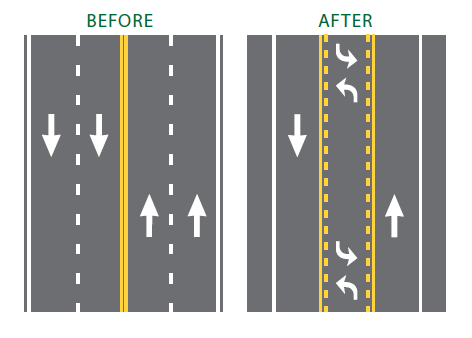Four to Three-Lane Conversion/Road Diet Summary

Illustration of the before and after of a four to three-lane conversion or road diet.
Image source: FHWA
What is a four to three-lane conversion or a road diet?
A four to three-lane conversion, also known as a road diet, is an infrastructure strategy which converts a traditional four-lane undivided configuration to a three‐lane undivided comprised of one through lane in each direction and a center two‐way left‐turn lane (TWLTL). The center TWLTL ultimately reduces the number of conflict points by removing left turning vehicles from the mainline. Road diets can also take the form of a converted six-lane undivided cross section to a five-lane cross section comprised of two through lanes in each direction and a center TWLTL. Conversion to a five-lane configuration occurs less frequently and consequently the benefits of the conversion are not nearly as well documented as the three-lane conversion. A four to three-lane conversion also commonly provides the option to install bicycle facilities on one or both sides of the through lanes. The bicycle enhancements coupled with a reduced number of conflict points along a corridor results in a safer and more complete environment for drivers as well as pedestrians.
Four to three-lane conversion/Road diet home
How effective is a four to three-lane conversion?
Four to three-lane conversions reduce the number of conflict points, particularly those with left‐turn movements, by removing the turning vehicles from the thru lane. Fewer conflict points along a section of road with a TWLTL ultimately reduces the total number of crashes. Four to three-lane conversions are an effective countermeasure to address rear‐end, right angle and head‐on crashes. The overall crash modification factors (CMFs) can range from 0.81 to 0.53, demonstrating a notable decrease in crashes. This range is based on characteristics of the site being considered. In Minnesota, average crash rates for three-lane facilities is 2.0 and 5.7 crashes per million entering vehicles (MEV) per year for four-lane facilities. The three-lane configuration crash rate is 46 percent lower than that of four-lanes. The CMF range is dependent upon the surrounding environment. Typically, larger CMFs are associated with more urban settings and smaller CMFs appear in more suburban or small town, environments. It is important to note that because of the decreased number of lanes, there exists the possibility for drivers to experience increased delay while traversing the three-lane section.
How does a three-lane roadway operate?
If daily traffic volumes remain relatively unchanged before and after the conversion, three-lane roads especially benefit in locations that have medium to high access densities. With fewer lanes, total throughput of vehicles may decrease, subsequently adding delay to the corridor. Four to three-lane conversion studies have demonstrated an upper limit of average daily traffic (ADT) of around 20,000 vehicles per day (vpd). Certain locations may be able to handle as much as a 25 percent increase in capacity while other locations may meet the estimated 20,000 vpd threshold before congestion occurs. Two local examples of three-lane roads in Minnesota with ADTs greater than 20,000 vpd are Rice Street and Lexington Avenue in Roseville. The number of intersection or driveway accesses along the roadway may also adversely affect a three-lane roadway's performance. A newly converted section of road containing multiple signalized intersections should have a traffic signal timing study to reduce undesirable congestion.
Where is the best place for a four to three-lane conversion?
When traffic congestion passes a certain threshold, historical practices would suggest widening roads and adding lanes. Converting two-lane roads to four-lanes was standard practice. However, data has shown that four-lane undivided roads have the highest crash rate of any urban cross section. Also, in urban/suburban retail areas that have a moderately high access density, four to three-lane conversions are typically a safer alternative. Converting four-lane roads to three-lanes ultimately reduce the amount of rear‐end and right angle crashes, especially those involved with left‐turn vehicle movements attempting to access businesses or residences. In either type of setting, urban or suburban, repurposing the road surface not only reduces the total number of lanes, but allows for bicycle enhancements and/or the addition of on‐street parking.
How expensive are four to three-lane conversions?
Four to three-lane conversions are typically a lower cost solution than reconstruction or expansion to a divided cross section to address higher crash rates and frequency of crashes. Unlike a costly reconstruction, a four to three-lane conversion typically only needs the surface to be re‐striped, signs installed and any signal heads to be realigned to the appropriate lanes. Conducting a traffic signal timing study may also be an appropriate step to assess the road’s performance.
Other considerations?
Anecdotal information that a moderate speed reduction has been observed along segments converted to three-lanes suggests that this cross section may be part of a speed management package. This conversion aims to help drivers perceive an urban environment and select an urban (30 mph) speed.
References
- FHWA, Road Diet Informational Guide. 2014 (FHWA‐SA‐14‐028)
- MnDOT, Safety and Operational Characteristics of Two‐Way‐Left‐Turn Lanes. (MN/RC 2006‐25)
- MDOT, Safety and Operational Analysis of 4‐lane to 3‐lane Conversions (Road Diets) in Michigan. (RC‐1555)
- FHWA, Evaluation of Lane Reduction “Road Diet” Measures on Crashes. 2004 (FHWA‐HRT‐04‐082)

